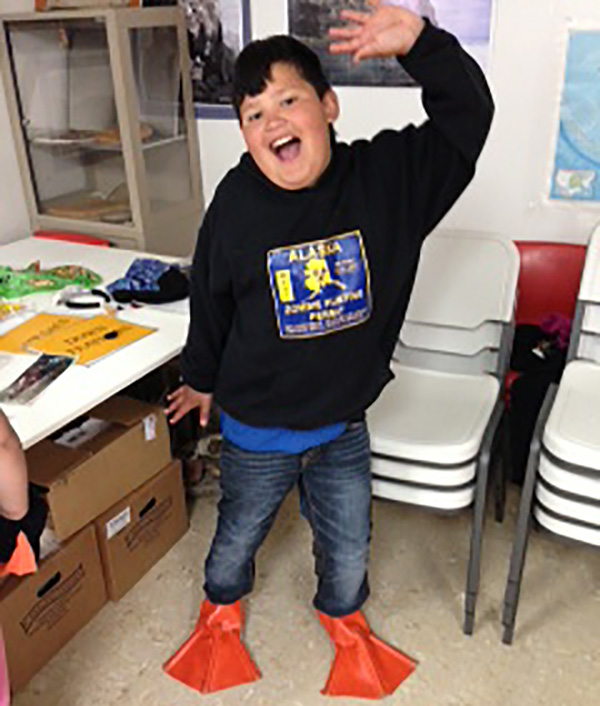Today marked the first day of the Seabird Youth Network Seabird Camp on St. Paul Island. Students arrived…(over 30 of them!) Began the day at the Civic Center with an introduction activity to learn each others’ names and something that we each enjoy about St. Paul Island. After each student introduced him/herself, a ball of yarn was to someone across the circle. The resulting web of yarn was used as a teachable moment to discuss the environment, food webs and how seabirds fit into the web, and how various factors could affect or collapse a food web. We built a seabird, showing the adaptations that seabirds have to live in a marine environment. Chauncey dressed up like a seabird front of the class and even flapped and danced around like a seabird!
Began the day at the Civic Center with an introduction activity to learn each others’ names and something that we each enjoy about St. Paul Island. After each student introduced him/herself, a ball of yarn was to someone across the circle. The resulting web of yarn was used as a teachable moment to discuss the environment, food webs and how seabirds fit into the web, and how various factors could affect or collapse a food web. We built a seabird, showing the adaptations that seabirds have to live in a marine environment. Chauncey dressed up like a seabird front of the class and even flapped and danced around like a seabird!
Students then broke out into three groups. One group went on a birding walk out to Reef Point cliffs, stopping at East Landing and various spots along the way. Students used binoculars and spotting scopes to learn to identify 9 species of seabirds: murres – thick-billed and common, black-legged kittiwakes, auklets – least, crested, and parakeet, puffins -tufted and horned, and glaucous winged gulls. A second group traveled to Antone breakwater to observe captures of Least Auklets. These birds are being studied by the USFWS-Alaska Maritime National Wildlife Refuge and scientists at UAF.
The third group went to Ridge Wall and visited with personnel from the Refuge. Biologists described to us the work that they do throughout the refuge and locally in the Pribilofs. They described how the nests are monitored for dates of when eggs are laid and chicks hatch. This data helps figure out if the birds are successfully breeding and fledging chicks. Students will rotate groups throughout the beginning of the week so they each get a chance at each activity.
St. George Camp had 11 kids….. ages 4-16! Oh My! The older students, Dani and Carmen, and visiting students, Erick and Sarah, are camp mentors. After a brief introduction to seabirds at the Rec hall we took the truck over to the Harbor to visit the Least Auklet colony. The younger kids decorated their own Least Auklet nest box, and we finished putting other boxes together. Down at the colony we installed nest boxes, observed and drew birds, used stopwatches to record how long individual birds were spending at the colony, and listened to auklets in their nest with a microphone. The weather was great, everyone had fun, and we all loved exploring the auklet colony.

